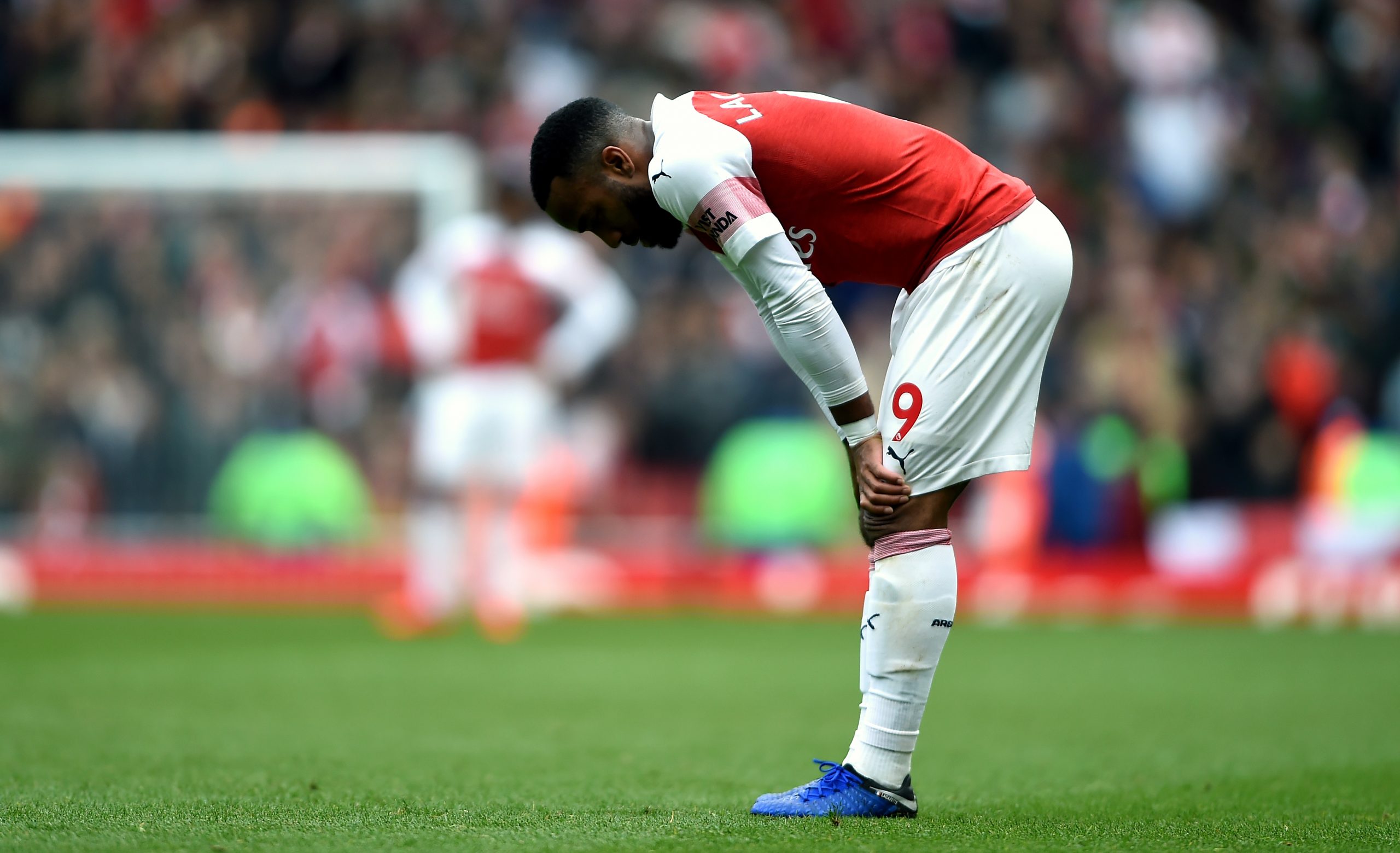The 2018–19 season was always going to be something of a transitional season for Arsenal. With Arsene Wenger’s 22 year tenure concluding last season, Unai Emery was inheriting a flawed squad that was top heavy in talent. The appointment of Emery in of itself was met with some trepidation, as there was a school of thought that Arsenal should’ve gone for the more unknown option in Mikel Arteta because the upside could’ve been greater. While the goal was to get back into the Champions League (preferably by finishing in the top 4), getting Arsenal to play a more modern game was also of importance.
On the face of it, one could say that season one of Emery has been a success. They finished with a higher point tally this season versus last (70 vs 63) while jumping up a spot in the table. They still have a shot at winning the Europa League and getting back to the Champions League, which is crucial given Arsenal’s current financial situation. Job well done, right? Well this type of thinking would be falling into the trap of looking at the results and foregoing the process. Arsenal’s declining performance has been a point of discussion on this site multiple times, but it bears repeating that there was a real decline in shot metrics from last season (which itself wasn’t a vintage Arsenal season) to this.
As the shot maps show, this season's goal return is mostly a mirage. They came in over expectation for the second season in a row.
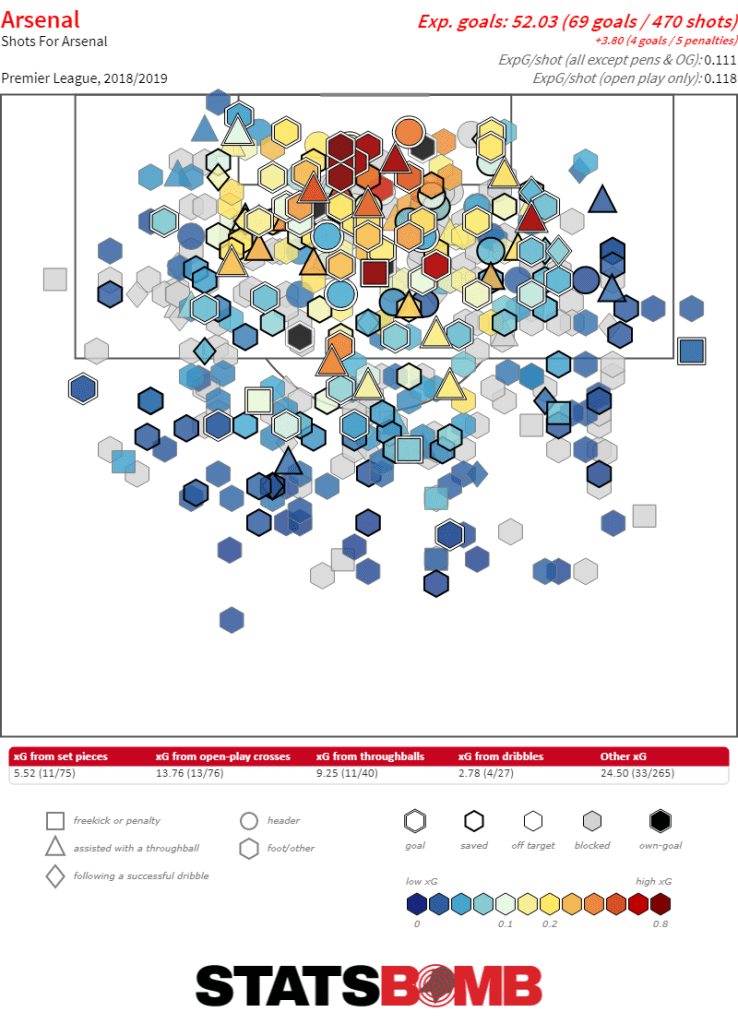
But, even if you believe that there is some systemic reason for overperformance, the fact is that they are still going the wrong direction, and their expected goals decreased despite the increase in goals scored.
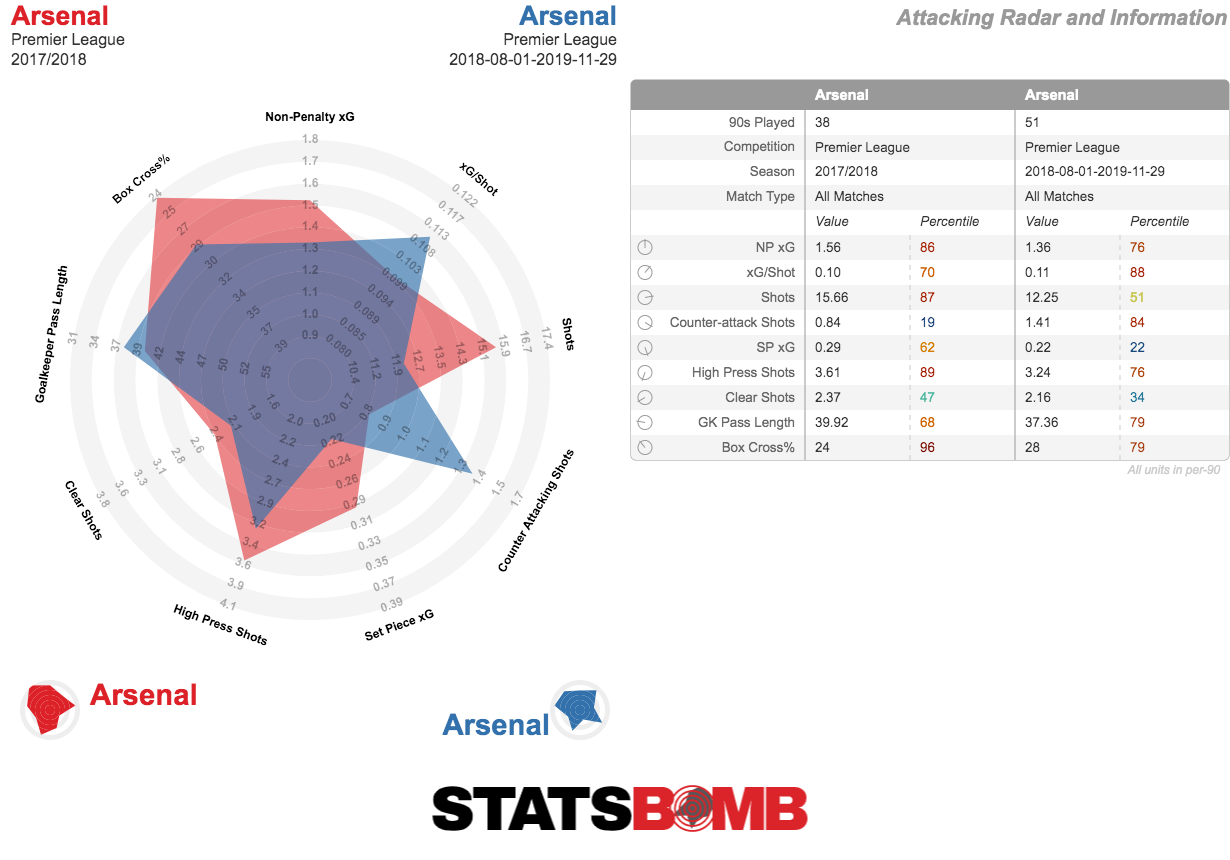
Things don't look prettier on the defensive side of the ball. The team came in ahead of where xG predicts, and despite that, the team still conceded more than last year.
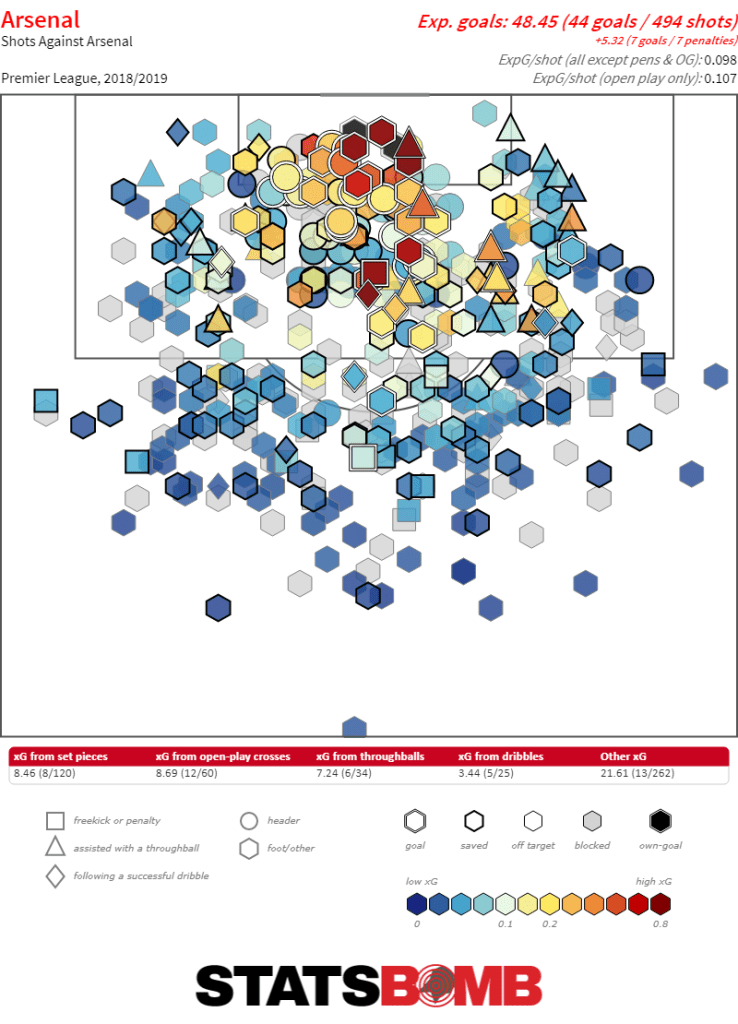
Last season, as the shot charts show, Arsenal were bad defensively, and also ran cold. This season they ran hot and were even worse.
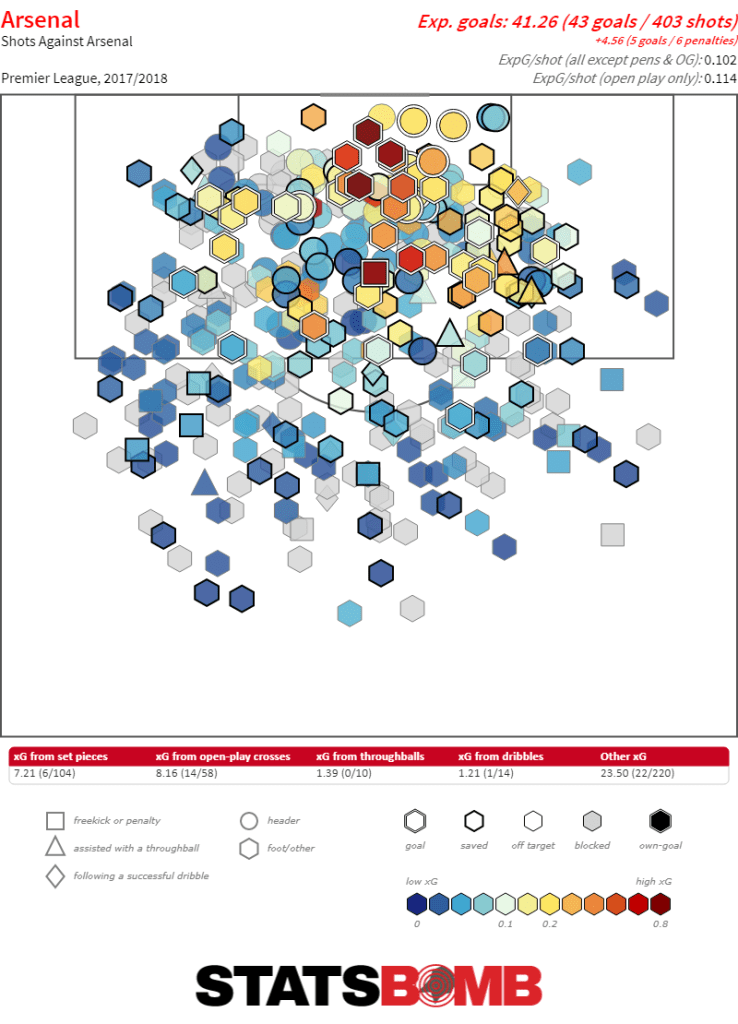
While there’s a degree of sympathy to be had towards Emery because of the weird state that Arsenal were when he took the job, it’s still worrying that their statistical profile resembles a mid-table club rather than one that pushed for the Champions League.
The aesthetics of Arsenal’s play haven’t been exceedingly better. A theme to have come out of preseason was Arsenal having more structure in their attack compared to the improvisational nature under Wenger, and while strong arguments could be made that this was for the betterment of Arsenal long-term, that did lead to growing pains in the intermediate. Part of those growing pains include a greater adherence to crossing the ball to create chances, going from 1st to 5th in lowest percentage of penalty box entries to come via crosses. Even during the good times, it still felt a bit textbook.
A trend under Emery in season 1 was the constant alternation between a cautious approach and a more aggressive game plan, and more times than not, leaning more towards the cautious end of the spectrum. Perhaps that was due to the suspect defensive talent that was on hand, but Emery’s cautiousness spread into other areas. There were matches when Arsenal could’ve loaded up heavier on attacking talent against inferior PL opposition without too much fear of it coming back to bite them, but that didn’t happen. That fed into Emery having to be aggressive with substitutions, and while it’s nice that he had a quicker hook than most managers, it’s fair to point out that was a byproduct of cautious squad selections.
It’s hard to talk about Emery’s handling of player usage without mentioning Mesut Özil and Aaron Ramsey, particularly in Özil’s case. We could debate the merits of his contract extension, but that’s its own separate discussion. Given the enormous wages + length of term that was given, there was no other feasible option coming into this season for Emery other than making use of Özil’s skillset and trying his hardest to make it work. That wasn’t the case though, as Özil only played in 1845 PL minutes. That low minute total might partly be chalked off to injuries, but it was abundantly clear that Emery didn’t think of him as a core player. From November 28 to March 1, Özil played a grand total of 364 PL minutes and only started 2 matches. That’s not an exemplary showing of maximizing resources, especially during the busiest part of the year.
Certainly, there have been bright spots this season for Arsenal, particularly the midfield duo of Lucas Torreira and Matteo Guendouzi. Between the two, Torreira was much more of a known commodity and was locked for a move to a big club by the end of the World Cup last summer. Guendouzi amounted to a lottery ticket that worked beyond even the most optimistic of scenarios. For a club that’s been criticized (rightfully) for their aversion towards accumulating young talent in the past, getting two above average young midfielders for less than £40M is a massive boon that will pay dividends for years to come.
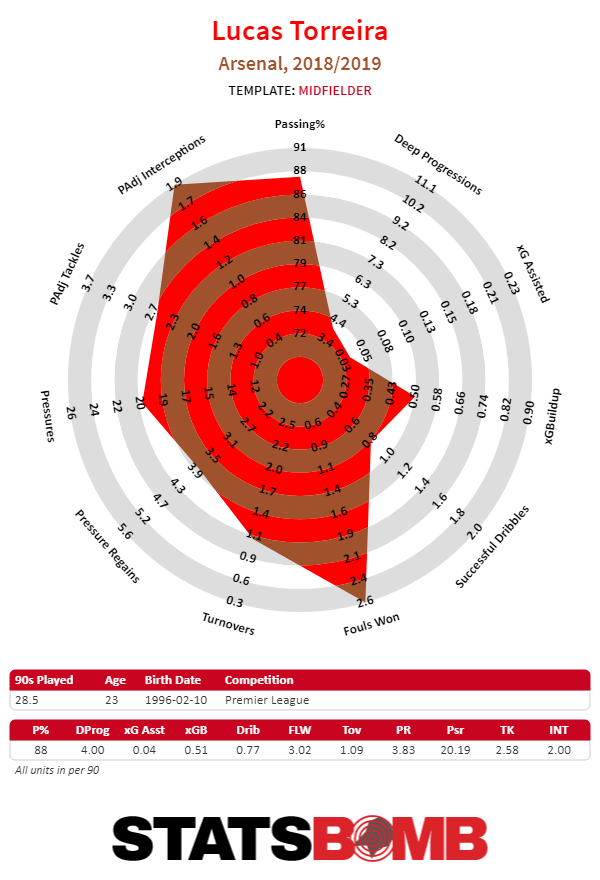
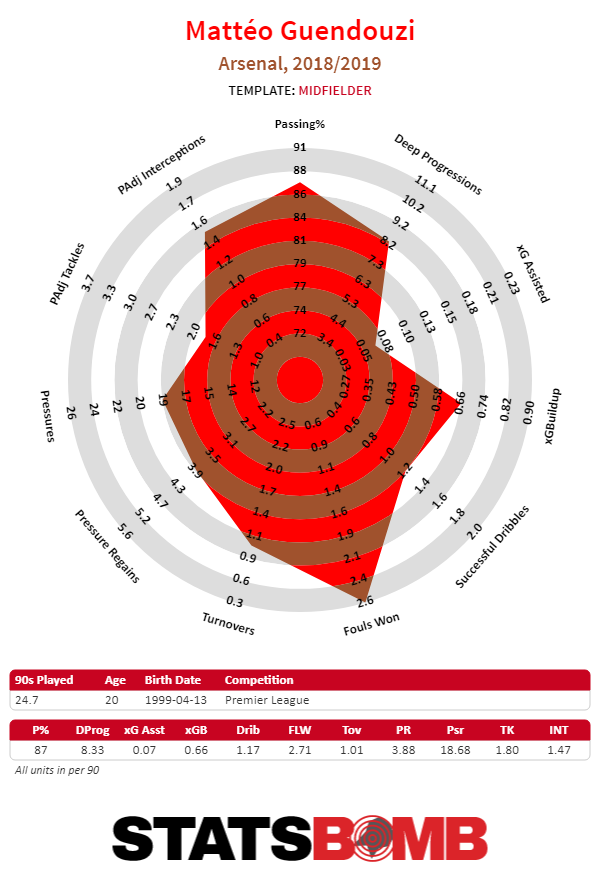
The acquisition of Bernd Leno was a contentious one given both the amount of money Arsenal paid for his service, along with the underwhelming shot-stopping track record that he possessed from the Bundesliga. To his credit, he performed closer to his best case scenario, ranking within the top 3 in StatsBomb's proprietary goals saved above average, and was a big reason why Arsenal didn’t concede even more goals than they did. While this in of itself was great, the fear is that Leno’s performance this season was such an outlier compared to previous ones, that it’s more likely he experiences a decline moving forward. If Arsenal’s defense doesn’t improve, anything short of a repeat performance from Leno could spell further trouble.
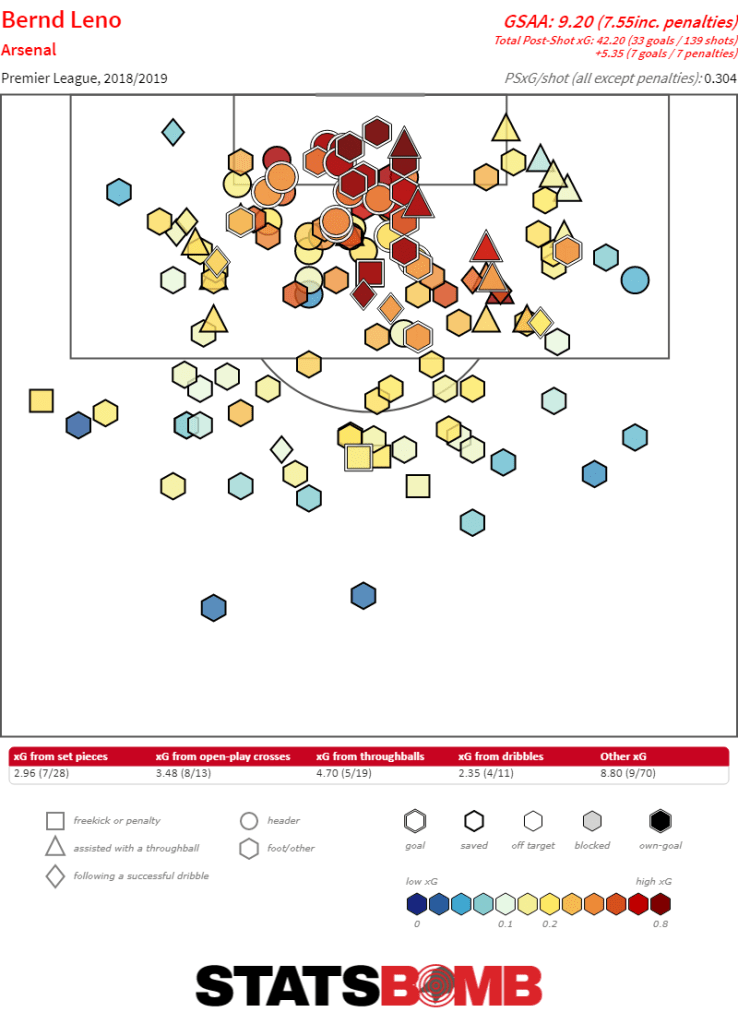
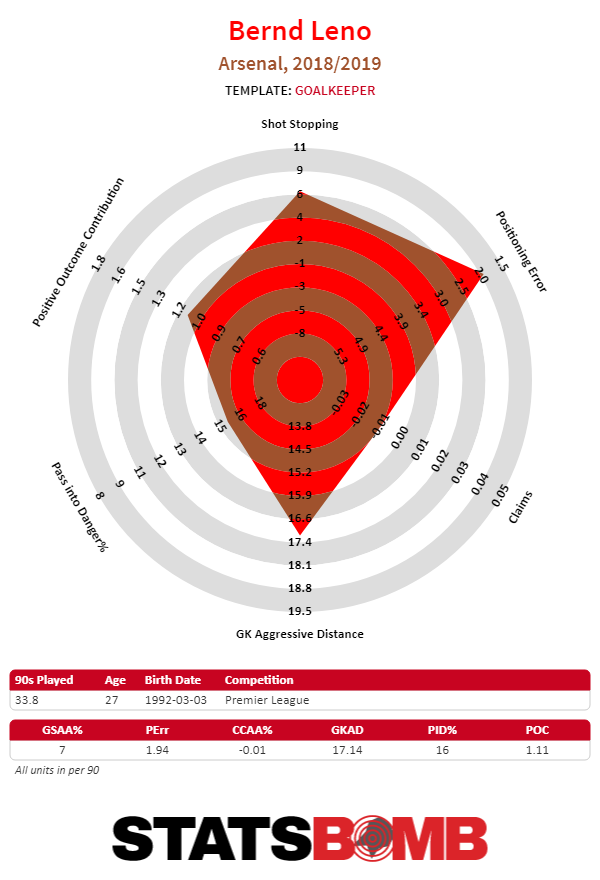
What’s interesting with Arsenal's positive variance in attack is that it wasn’t primarily driven from their striker duo in Pierre-Emerick Aubameyang and Alexandre Lacazette, but rather a collective effort. Certainly, Aubameyang and Lacazette had noteworthy seasons. Lacazette once again had his xG contribution per 90 hover around the 0.5–0.6 per 90 range (0.5 to be exact), while Aubameyang compensated for a modest shot volume (2.75 shots per 90) by having ruthless efficiency in his shot location. Averaging an xG/shot of 0.195 is elite territory, and it highlights just how great Aubameyang is at leveraging his off-ball movement into creating quality scoring chances for himself in the box.
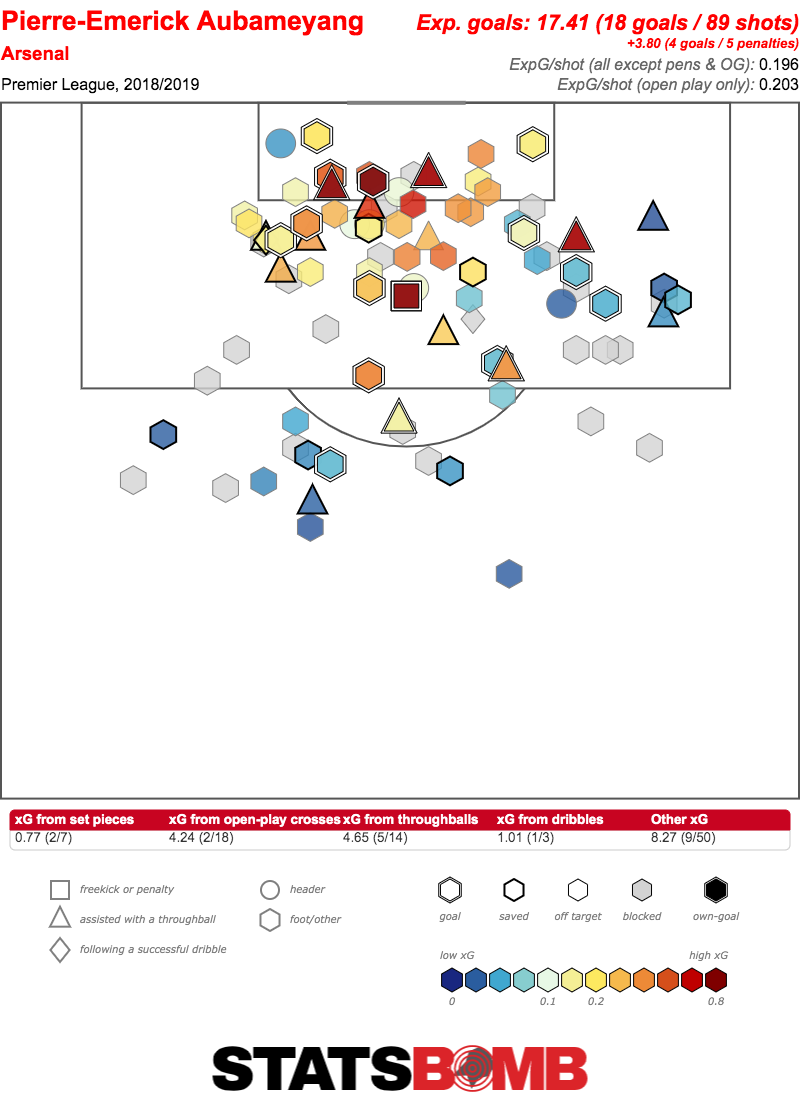
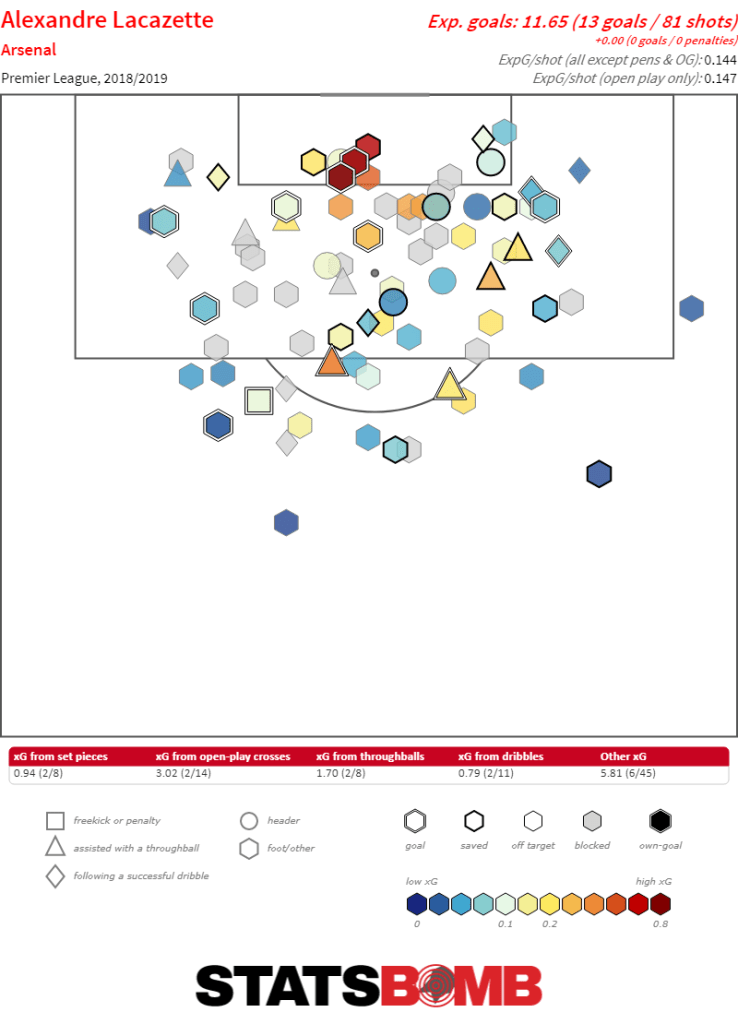
Bright spots notwithstanding, It’s hard to escape the feeling that even with the built in sympathy that Emery had coming into Arsenal, his debut season was somewhat of a disappointment. Their performance indicators declined from last season despite having comparable collective talent, and given how Tottenham, Chelsea, and Manchester United did all they could to gift wrap a top four spot for Arsenal, not being able to take advantage of those numerous slip-ups stings even more. Even if one was to be forgiving of missing out on a top four spot, having a 38-game sample that produced more questions than answers in terms of style of play and balancing conservatism and proactive football doesn’t assuage concerns.
If we were to compare Emery’s first year with other managers within the big six, one comparison that would be tempting to make is with Mauricio Pochettino’s debut season at Spurs in 2014–15. Despite Spurs finishing 5th that season, they were buoyed by Hugo Lloris’ shot stopping along with Harry Kane and Christian Eriksen’s finishing. Even then though, it was clear what Pochettino was trying to implement, but he didn’t have the horses to make it work right away. The problem is that it’s harder to make that argument with Emery at Arsenal.
Moving forward, Arsenal’s outlook is far from rosy. Though qualification for the Champions League (via the Europa League) is crucial, they’ll still looking at a massive rebuild/retool job that will be hard to cover with the transfer budget they’ll be allotted this summer. Arsenal need to inject new blood in numerous positions (CB/LB/CM/Wings), and they might not have the funds to cover a couple of needs unless they do extremely well on the margins. There’s further worry coming from the fact that there are worthy candidates below the big 6 in Leicester and Wolverhampton, who if they execute good-great summer windows in their own right, could realistically convince themselves that they could pounce on an opportunity to vault into the top 4–6. Though it feels like forever that the big 6 has been a staple of the Premier League, it’s only been the last three seasons where that’s been the case. While many have assumed a future where the PL will be status quo up top, these things are more fluid than perhaps it’s given credit for.
Arsenal should be mildly worried about the potential of slipping into mid-table because they have downside risk coming from the current squad construction, the reliance on older players, and the limited amount of assets that can be sold at close to top value. A good number of Arsenal’s main contributors are late peak-age or already at the wrong end of the age curve. More than anything, a big worry for Arsenal has been the collective decline in athleticism and dynamism over the years. Look up and down the roster, and there’s a noticeable lack of eye-popping young talent. This is the byproduct of years of neglecting to prop up a young, talented nucleus. Even with Arsenal ranking as one of the richest clubs in Europe, bridging the gap between themselves and the very top of European football has to involve taking more educated shots at young prospects. Getting Guendouzi and Torreira last summer was a good start, but that’s all that it was, a start.
Certainly despite the budget constraints, there are still ways for Arsenal to go about trying to fill as many holes as possible this summer through young talent accumulation. With Guingamp relegated from Ligue 1, Marcus Thuram should emerge as a cheap young option for Arsenal to look at who could replace Danny Welbeck as a utility option, with perhaps some further room for role upside given his age. Arsenal could do much worse than reviving their interest for Cristopher Nkunku and adding him to the young core of talent that they are trying to build. With this being the summer that PSV will probably look to sell high on their young talent, Angeliño is an option at LB that Arsenal could explore, even with the usual caveats involving young Eredivisie talent translating into the Premier League.
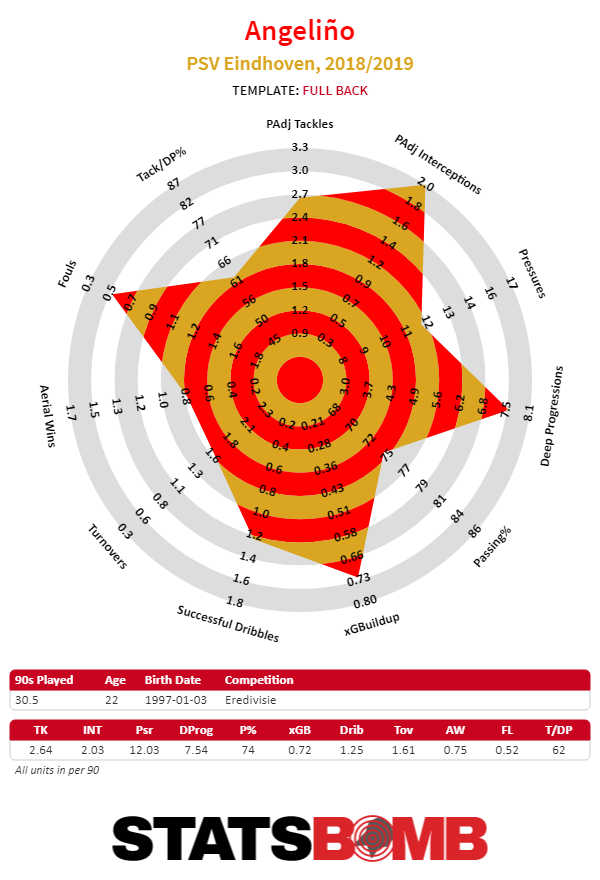
The seven point increase from last season to this belies the precarious situation that Arsenal are facing, and the grim reality that they were lucky to accumulate 70 points despite only having mid-table shot metrics. The 2018-19 season was far from a vintage Arsenal season, having to rely on lots of positive variance in attack along with an excellent Leno season. It brings into question the coaching job that Emery did, even though some have pointed to an increase point total as proof of a successful debut year. The cumulative damage from years of squad mismanagement has left them with a roster that is short on prospects that are worthy building blocks, and having limited transfer funds to cover up the holes in place (especially if they don't win the Europa League).
It is certainly possible that Arsenal could win the EL, and execute a very good summer window where they bring in ample amounts of young talent on a tighter budget. However, if that doesn't happen, then there's the real potential of Arsenal slipping out of the big 6 and descending further into chaos.
